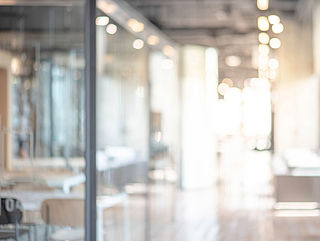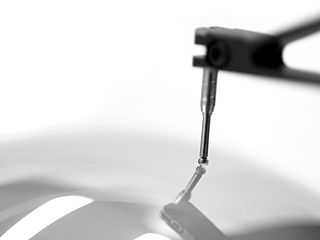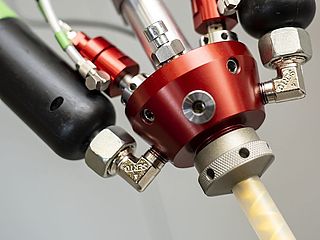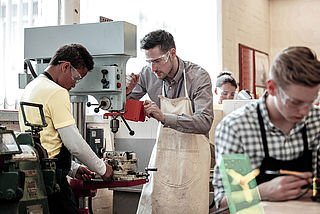New process for old treasures

Time and again, criminal gangs manage to pull off spectacular burglaries in museums - as recently in the Green Vault in Dresden or the Bode Museum in Berlin. On the black market, the stolen exhibits are worth millions. At the same time, the demand for art and cultural assets is increasing on the international stage and does not stop at looted art and stolen goods. "The looting of unprotected archaeological sites and the illegal trade in cultural goods are a huge problem," says Dr. William (Bill) Wei, retired Senior Conservation Scientist. He worked for many years at the "Rijksdienst voor het Cultureel Erfgoed," the Dutch cultural heritage office. It has often been possible to find evidence of looted art from collections or civil war zones in renowned museums. These museums had obviously not looked very closely when purchasing the exhibits. For these reasons, the international art community has long been calling for so-called "object passports" for works of art and cultural history. They are supposed to provide buyers with reliable proof of origin and thus protect against forgeries or stolen goods. This would also be of invaluable help to customs.
EU project with Mahr technology
ut how can works be permanently protected against theft? How can they be made absolutely forgery-proof? And how can a museum ensure that originals lent to special exhibitions are actually returned - and not well-made forgeries? From 2005 to 2008, the EU project "FING-ART-PRINT" developed a promising solution to this problem, which has now been confirmed once again by long-term studies: Like every work of art itself, its surface structures are unique at the micrometer level. The researchers in Bill Wei's team scanned them using 3D metrology to create a kind of fingerprint. And it is indeed just as unique as the human fingerprint. "This type of fingerprint is recorded at any secret area of the object and can be easily matched when exhibits are returned or when they go through customs," explains Wei, a cultural property conservationist. As part of the FING-ART-PRINT project, Wei examined the surface structures of more than thirty objects provided by ten museums and two private galleries.

The method
The basis for the measurements is confocal technology, which metrology specialist Mahr has developed at its site in Oberhausen. In general, confocal technology makes use of the fact that different height/depth levels of a surface can be observed by moving the microscope lens up and down. The confocal microscope "scans" through all the levels and assembles them into a topographic map in a matter of seconds. "Meanwhile, a spatial resolution of less than one micrometer and a deep resolution of less than 0.2 micrometer are possible, which is more than sufficient for a fingerprint that cannot be falsified," the researcher explains. The roughness data are available as ASCII files, and the topographic maps as JPEG files, making them compatible with any archiving system. Customs officials could use FING-ART-PRINT to match "fingerprints" of items against international databases.
Measurements in detail: experimental setups
For FING-ART-PRINT, the fingerprints were first captured with a tabletop device from the MarSurf CM series. A 10x lens was used, which provided a distance of ten millimeters to the object. The lens of the 3D device has a field of view of approximately 1.6 × 1.6 millimeters. A spatial resolution of three to four micrometers and a depth resolution of one micrometer were chosen for the measurement. Taking a fingerprint of this size and with this resolution takes less than 30 seconds. "The advantage of the tabletop model is its stability. However, the fixed geometry of the setup limits the size and shape of objects and the choice of location for "fingerprints," or scans, because they must be positioned under the narrow objective lens. This also makes it difficult to retrieve a fingerprint," explains Bill Wei. In a second setup, the device, which was developed as the MarSurf CM mobile for mobile applications, was mounted on a robotic arm and moved flexibly to the objects. The advantage is that the fingerprint can be taken at almost any location; a webcam documents its exact position. The MarWin evaluation software has an image matching algorithm that uses the webcam images to help the user locate the fingerprints when positioning the object later.

Long-term tests confirm durability
To ensure that the fingerprints are preserved over the long term, further studies were carried out on their durability. Renewed test series after fifteen years have currently shown that the roughness does not change significantly over the period. An exception is the roughness of fresh paints that have not yet dried through. Cleaning or accidental damage to objects also affect the measurement result. The results of the FING-ART-PRINT project thus show that fingerprinting is a promising way to identify items and protect them from theft and illegal trade. As of 2019, there is now a dedicated MarSurf CM mobile in Bill Wei's former office; he himself is now retired, but continues to actively research. Fingerprints can thus be used as part of an object passport, one of the cornerstones for combating the illegal trade in cultural heritage objects. After the successful long-term tests, the researcher is now looking for partners to market this system internationally.






















